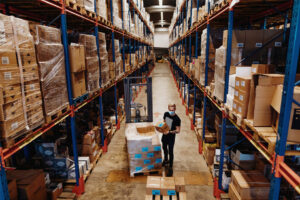 Analyst Insight: This year marks the first time that the U. S. has started a new calendar year with actionable climate policies in place. Investors and consumers, meanwhile, are paying more attention to corporate sustainability efforts.
Analyst Insight: This year marks the first time that the U. S. has started a new calendar year with actionable climate policies in place. Investors and consumers, meanwhile, are paying more attention to corporate sustainability efforts.
Shippers today face growing pressure to increase supply chain visibility and comply with new climate policies. In the process, they need to determine whether sustainability efforts are working together holistically, for the benefit of their entire supply chain and greater sustainability strategy.
Policies such as the Inflation Reduction Act and the Infrastructure Investment and Jobs Act, which delegated $659.7 billion to climate-related programs and projects, propose strict guidelines and mandates, as well as incentives for decarbonization. The pressure to take advantage of these incentives has increased as sustainability efforts have become imperatives across a range of stakeholders.
It can be tough for shippers to align processes in order to meet sustainability goals. This is largely due to the unique nature of each transportation network, in addition to current economic conditions and the prospect of a recession. To earn the most value from their decarbonization initiatives, shippers need to curate a plan that prioritizes big-picture sustainability and operational supply chain goals. Following are the top strategies to consider.
Zero in on real-time data. There’s no one-size-fits-all approach when it comes to reducing emissions in the transportation sector. Shippers across industries are on vastly different journeys when it comes to making progress on sustainability initiatives. Some are just beginning; others don’t know where to start, and a few with strong foundations are looking to build more sophisticated and advanced strategies. Regardless of where a shipper is on its sustainability roadmap, one strategy tends to get overlooked, yet promises to have a significant impact on transportation, is tracking and collecting granular data. More often than not, shippers are relying on data that provides an imprecise snapshot into a specific period of time, such as using annual fuel purchase data to gauge emissions, and employing blended averages for lifecycle carbon-intensity calculations. Often these delayed and imprecise snapshots won’t provide a complete enough picture to make a permanent change, especially when it comes to decreasing Scope 1 and Scope 3 emissions. By prioritizing real-time data and transparency, shippers can harness the full potential of the significant sustainability changes to transportation beyond the next decade, including the proliferation of autonomous and alternative energy vehicles.
Take the time to strengthen and re-evaluate partnerships. Realistically, shippers can’t undergo holistic sustainability practices alone, so it’s critical that they forge strong partnerships with carriers. This creates an opportunity for the request-for-proposal (RFP) process to align, and devise a plan that incorporates sustainability with like-minded partners. To achieve this, shippers should consider their current network to see what’s working, what’s not, and what sustainability goals they want to make progress on in 2023. How are current carrier partners an extension of this? Which sustainability initiatives are transportation leaders implementing, and which carriers are meeting that bottom line? By narrowing in at the lane level and outlining specific strategies and carrier partners’ roles in them, shippers can create an interconnected effort toward decarbonization.
Track progress, stack wins and iterate as needed. The transportation industry continues to evolve. To ensure that sustainability initiatives are making real progress, it’s critical for shippers to actively measure and monitor changes. As decarbonization remains a top priority, there will continue to be a mosaic of technologies and tactics available for shippers to consider. It’s critical for them to take a strategic approach to decision-making, one that prioritizes compounding wins that lead to broader sustainability goals. Keep in mind that such wins are incremental improvements toward achieving sustainability goals. By encouraging actions like selecting carriers with lower carbon-intensity scores, employing mode conversion or using alternative energy sources wherever it makes sense, shippers can build momentum while enabling cross-functional engagement.
Even against the backdrop of economic uncertainty, now is the time for shippers to prioritize their sustainability initiatives. By stacking incremental improvements and tactics that work together holistically and cohesively, they can ensure that their sustainability strategies can better withstand ever-changing legislative and economic environments. The transportation industry continues to face changes and hurdles daily, by by tracking and collecting real-time data, strategically expanding toolsets, creating valuable partnerships and tracking progression, shippers can make significant progress toward carbon reduction goals, and ultimately make the Paris Agreement a reality.
- SEO Powered Content & PR Distribution. Get Amplified Today.
- PlatoAiStream. Web3 Data Intelligence. Knowledge Amplified. Access Here.
- Minting the Future w Adryenn Ashley. Access Here.
- Buy and Sell Shares in PRE-IPO Companies with PREIPO®. Access Here.
- Source: https://www.supplychainbrain.com/articles/37214-how-to-prioritize-holistic-sustainability-strategies-in-2023
- :has
- :is
- :not
- :where
- 1
- 2023
- 7
- a
- Achieve
- achieving
- across
- Act
- actions
- actively
- addition
- advanced
- ADvantage
- against
- Agreement
- align
- alone
- alternative
- an
- and
- annual
- approach
- ARE
- AS
- At
- attention
- autonomous
- available
- backdrop
- BE
- become
- Beginning
- benefit
- Better
- Beyond
- Billion
- Bottom
- broader
- build
- by
- Calendar
- CAN
- carbon
- Carbon Reduction
- carriers
- chain
- change
- Changes
- Climate
- Collecting
- comes
- complete
- conditions
- Consider
- Consumers
- continue
- continues
- Conversion
- Corporate
- create
- creates
- Creating
- critical
- Current
- daily
- data
- decade
- decarbonization
- Decision Making
- Delayed
- Determine
- devise
- different
- Dont
- due
- each
- earn
- Economic
- Economic Conditions
- economic uncertainty
- effort
- efforts
- Emissions
- enabling
- encouraging
- energy
- engagement
- enough
- ensure
- Entire
- environments
- especially
- ever-changing
- evolve
- expanding
- extension
- Face
- few
- First
- first time
- following
- For
- forge
- Foundations
- from
- Fuel
- full
- get
- Goals
- greater
- Growing
- guidelines
- Have
- holistic
- How
- How To
- HTTPS
- Hurdles
- Impact
- implementing
- improvements
- in
- Incentives
- Including
- incorporates
- Increase
- increased
- industries
- industry
- inflation
- Infrastructure
- initiatives
- insight
- interconnected
- into
- investment
- Investors
- IT
- ITS
- Jobs
- Journeys
- just
- Keep
- Know
- Lane
- largely
- lead
- leaders
- left
- Legislative
- Level
- lifecycle
- like
- like-minded
- Line
- looking
- make
- MAKES
- Making
- mandates
- Meanwhile
- measure
- Meet
- meeting
- mind
- Mode
- Momentum
- Monitor
- more
- most
- Nature
- Need
- needed
- network
- New
- next
- no
- now
- of
- often
- on
- ONE
- operational
- Opportunity
- or
- order
- Others
- paris
- Paris Agreement
- partners
- partnerships
- paying
- period
- permanent
- picture
- Place
- plan
- plato
- Plato Data Intelligence
- PlatoData
- policies
- potential
- practices
- pressure
- Prioritize
- prioritizing
- priority
- process
- processes
- Programs
- Progress
- progression
- projects
- promises
- propose
- prospect
- provide
- provides
- purchase
- range
- real
- real-time
- real-time data
- Reality
- recession
- reducing
- reducing emissions
- reduction
- Regardless
- remains
- roadmap
- roles
- s
- scope
- sector
- see
- selecting
- sense
- should
- significant
- Snapshot
- So
- some
- sophisticated
- Sources
- specific
- stack
- stacking
- stakeholders
- start
- started
- Strategic
- strategic approach
- Strategically
- strategies
- Strategy
- Strengthen
- strict
- strong
- such
- supply
- supply chain
- Supply Chain Visibility
- Sustainability
- tactics
- Take
- Technologies
- than
- that
- The
- their
- Them
- There.
- These
- they
- this
- this year
- time
- to
- today
- together
- toolsets
- top
- toward
- Tracking
- Transparency
- transportation
- Ultimately
- Uncertainty
- unique
- using
- Valuable
- value
- Vehicles
- visibility
- want
- WELL
- What
- when
- whether
- which
- while
- will
- Wins
- with
- Work
- work together
- working
- year
- yet
- zephyrnet












